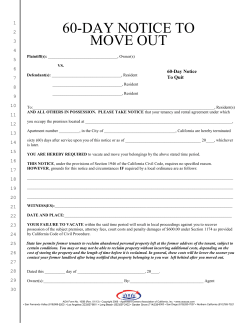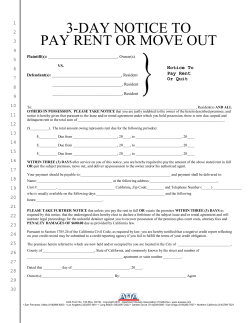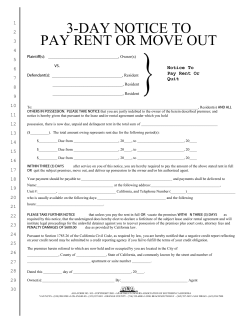
How to Calculate % Eaten In-Service Lea Hyland, MS RD LD
How to Calculate % Eaten In-Service Lea Hyland, MS RD LD (Non-commercial use only - compliments of Arkansas Academy of Nutrition and Dietetics) 2014 All Rights Reserved Learning Objectives 1. 2. 3. Identify Common Causes of Weight Loss Identify effect of proteincalorie under nutrition which results in weight loss Demonstrate accurate calculation of percentage consumption of sample trays. In-Service Overview A. Goals for & responsibilities to the residents of long term care facilities B. Purpose of monitoring weight & percentage eaten C. Causes of wt loss in older persons? In-Service Overview – Cont. D. ? happens to body composition with wt loss and gain cycles E. Effect of wt loss (protein-energy) undernutrition in older persons F. Prevention Goals & Responsibility z Quality of Care z Quality of Life Why Monitor Wt & % Eaten z Weight Hx is MAJOR indicator of nutritional status z Answer questions K4c and K6a z Quickest Indicator or trigger Monitor Wt & % Eaten – Con’t z Wt loss corresponds to increased morbidity and mortality z Weight fluctuation of 3+ lbs reflects hydration status. Causes of Wt loss in older persons? Medications z Emotional Probs (depression) z Anorexia, Alcoholism z Late-life paranoia z Swallowing problems z Causes of Wt loss in older persons? – Con’t z z z z Oral Factors (i.e., dentures, caries) No money (poverty) Wandering (dementia-related behaviors) Hyper/Hypo - thyroidism, hyperparathyroidism/hypoadrenalism z z z z Enteric Problems Eating Problems (inability to self feed) Low-Salt, Low Cholesterol diet Stones, social probs Multi - Factors Social z Psychological z Medical z Age Related z Needs Interdisciplinary Team Approach Percent of Weight Loss Lean Body Mass Fat Starvation OR Fasting 68 % 32 % Ketogenic Diets < 1000 Kcal/day 65 % 35 % Mixed Food Diets < 1000 Kcal/day 40 % 60 % Mixed Food Diets > 1000 Kcal/day 32 % 68 % Mixed Food Diets + Mild Exercise > 1000 Kcal/day 21 % 79 % Effects of Protein Calorie Under-Nutrition z z z z z z z z z z Anemia Decreased cognition Edema Falls Hip fractures Immune dysfunction Infections Muscle Loss Osteoporosis Pressure sores Ounce of Prevention……. z z z z z z Decreased ability to accomplish ADL’s Increase work loads for caregivers Malnourished elderly require more aggressive nutrition therapies Monitoring % Eaten more accurate than pie charts < 75% eaten requires closer monitoring and assessment – Substitutes offered, etc Federal regs require meal intake documentation How to Calculate % Eaten z Count # of servings on the tray z DO NOT count garnishes, coffee, tea, water, condiments, milkshakes or canned supplements if they are not a part of the planned menu How to Calculate % Eaten z Estimate total servings eaten by adding up amount eaten of each serving How to Calculate % Eaten z Round total serving eaten down to nearest ½ How to Calculate % Eaten z Refer to Chart 1. 2. 3. 4. 5. Locate total servings across top Locate total eaten on left side Locate % Eaten Record % Eaten for each resident on the appropriate form for your facility Chart supplements separately Frequently Asked Questions 1. What about double portions? Answer: ½ of 1 serving OR 1 serving of 2 will cause the % to vary only a few points. Frequently Asked Questions 2. What constitutes a “serving” of something? Answer: If the serving size looks to be ½ cup, it counts as a serving. Pureed diets would be an exception. Some fresh foods would pureed down to smaller portions sizes. Frequently Asked Questions 3. How do I know if the milkshake or supplement on a resident’s tray is on the menu? Answer: Is the food item on every resident’s tray receiving that particular diet? Most facilities do not include milkshakes or supplements as part of the menu. Here’s How Example Refer to tables on page 3 as you review the following pictures Meal as served Coffee Milk Chicken Potato Salad Backed Beans Bread Pie Tomato Garnish Meal as eaten Coffee Milk Chicken Potato Salad Backed Beans Bread Pie Tomato Garnish Practice Activity #1 Item on Tray #1 #2 1/2 All None Toast None ½ ¾ Eggs All None ½ Cereal ½ All ½ Milk ¾ ¾ ½ Coffee All All All Orange Juice #3 Resident #1 Total Number of servings: Orange Juice 1/2 Toast None Eggs All Cereal ½ Milk ¾ Coffee All 5 1/2 0 Total: 1 2¾ 1/2 Round Down 3/4 2½ 0 Resident #2 Total Number of servings: Orange Juice All Toast ½ Eggs None Cereal All Milk ¾ Coffee All 5 1 1/2 Total: 0 3¼ 1 Round Down 3/4 3 0 Resident #3 Total Number of servings: Orange Juice None Toast ¾ Eggs 1/2 Cereal 1/2 Milk 1/2 Coffee All 5 0 3/4 Total: 1/2 2¼ 1/2 Round Down 1/2 2 0 Refer to Chart z Find number of servings eaten across the top and the total number of servings counted along the side #1 #2 #3 50 % 60 % 40 % Practice Activity #2 Item on Tray #1 #2 Meat 1/2 All None None ½ 3/4 Potato All None ½ Bread ½ All None Fruit ¾ ¾ 1/2 Dessert ½ ½ All Garnish All All None Water 1/2 1/2 1/2 Coffee All All All Sugar Creamer, Salt, Pepper All All All Milkshake ½ All 1/2 Vegetable #3 Resident #1 Total Number of servings: 6 1/2 ½ None 0 Potato All 1 Bread ½ ½ Fruit ¾ ¾ Dessert ½ ½ Round Down Garnish All 0 3 Water 1/2 0 Coffee All 0 Salt, Pepper All 0 Milkshake ½ 0 Meat Vegetable Total: 3¼ Resident #2 Total Number of servings: 6 Meat All 1 Vegetable ½ 1/2 Potato None 0 Bread All 1 Fruit ¾ 3/4 Dessert ½ 1/2 Water ½ 0 Coffee All 0 Sugar, Creamer All 0 Salt, Pepper All 0 Milkshake All 0 Total: 3¾ Round Down 3½ Resident #3 Total Number of servings: Meat Vegetable 6 None 0 3/4 3/4 Potato ½ Bread None 0 1/2 1/2 Dessert All 1 Water ½ 0 Coffee All 0 Sugar, Creamer All 0 Salt, Pepper All 0 1/2 0 Fruit Milkshake 1/2 Total: 2 3/4 Round Down 2½ Refer to Chart z Find number of servings eaten across the top and the total number of servings counted along the side #1 #2 #3 50 % 58 % 42 %
© Copyright 2025












